We visited Bulguksa Temple in Gyeongju, South Korea, an Unesco World Heritage Site built in 535 by King Pob-hung for his queen to pray for the kingdom's welfare. The temple was destroyed and partially rebuilt during Japanese occupation and fully restored under President Park Chung-hee. Today it is home to seven Korean national treasures and features a large water wheel called Bomun Mulebanga, symbolizing mental clarity and fulfillment of dreams.
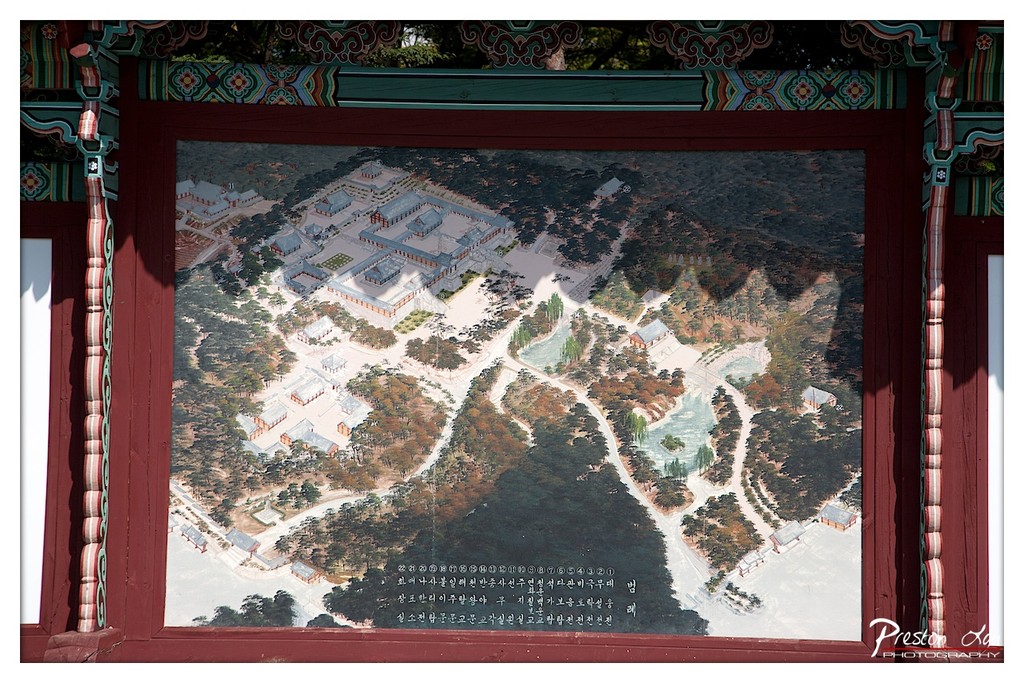

1. Overall Rating (0–10) — 7.0
This photograph captures a traditional Korean architectural map framed within an ornate, hand-painted wooden structure, blending cultural heritage with visual storytelling. The intricate details of the painted frame contrast beautifully with the historical illustration, creating a layered sense of time and place. While the image is rich in cultural context, the slightly overexposed sky and flat lighting reduce its visual depth, keeping it from achieving full artistic resonance.
2. Composition (0–10) — 7.5
The central placement of the map within the ornate frame creates a strong focal point, with the symmetry of the architectural elements guiding the eye naturally toward the illustration. The surrounding frame acts as a visual border, enhancing the sense of inclusion and tradition, though the slight asymmetry in the frame’s perspective introduces a subtle imbalance.
3. Lighting (0–10) — 6.0
Natural daylight illuminates the scene evenly, but the bright overhead sun creates harsh highlights on the upper frame and slightly washes out the details of the painting. The contrast between the shaded areas and bright exposure detracts from the subtle textures of the wood and paint.
4. Color & Tone (0–10) — 7.5
The rich reds and greens of the painted frame contrast beautifully with the earthy tones of the map, creating a harmonious palette that reflects traditional Korean aesthetics. The warm color temperature enhances the cultural authenticity, though some color saturation in the sky reduces overall tonal richness.
5. Creativity (0–10) — 7.0
The image successfully combines historical documentation with artistic framing, presenting the map not just as information but as a cultural artifact. The integration of the ornate architectural elements into the composition elevates the photograph beyond a simple snapshot into a reflective commentary on heritage.
6. Technical Quality (0–10) — 7.0
The image is sharp and detailed, particularly in the painted frame and the text on the map. Focus is consistent across the central subject, and the resolution captures the fine textures of the wood and paint. However, minor overexposure in the upper section slightly undermines the technical precision.
7. Emotional Impact (0–10) — 6.5
The photograph evokes a sense of reverence and nostalgia, inviting the viewer to reflect on tradition and continuity. While the emotional pull is moderate due to the flat lighting and composition, the cultural significance of the subject matter lends a quiet dignity to the scene.
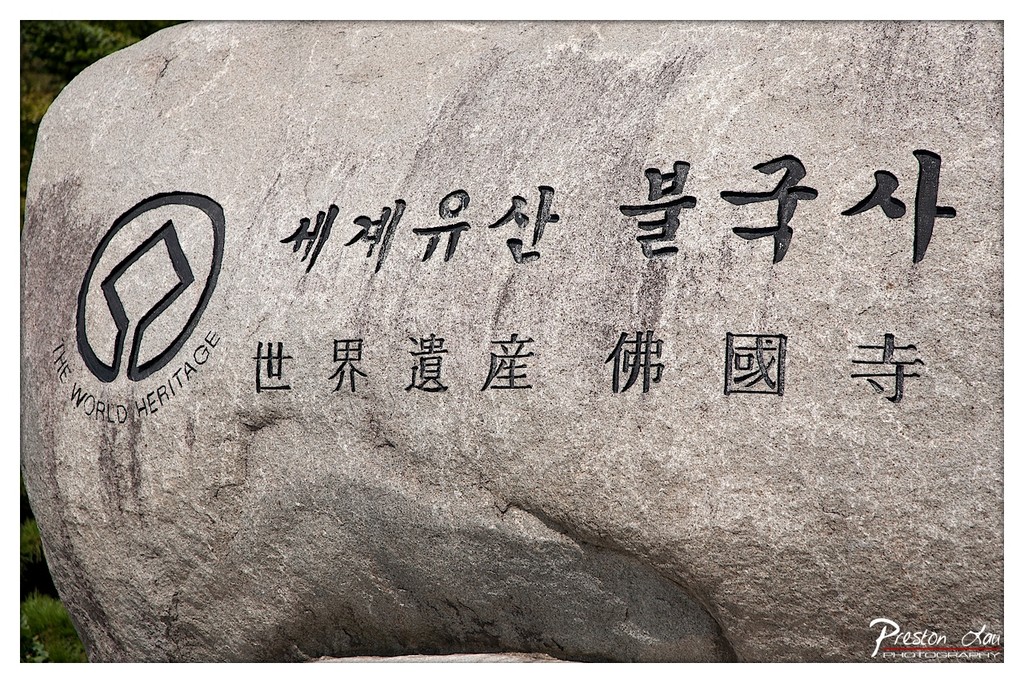

1. Overall Rating (0–10) — 7.0
This image captures a solemn and culturally rich moment, honoring the heritage of Bulguksa Temple with a strong sense of place and purpose. The textured stone and multilingual inscriptions convey authenticity and reverence, while the clean framing emphasizes the monument’s significance. A more dynamic lighting approach could elevate the emotional weight, but as a document of cultural identity, it succeeds in grounding the viewer in its historical context.
2. Composition (0–10) — 7.5
The stone is centered with balanced framing, allowing the inscriptions and UNESCO logo to dominate the visual field. The slight tilt adds subtle dynamism without disrupting the image’s gravitas.
3. Lighting (0–10) — 6.5
Natural daylight provides even illumination, highlighting the stone’s texture and the carved lettering. The shadows are soft and diffuse, preserving legibility but lacking the dramatic contrast that might enhance depth.
4. Color & Tone (0–10) — 7.0
The neutral palette of gray stone and black engraving creates a dignified, restrained tone. The absence of vibrant color reinforces the image’s solemnity, though a touch of warmth in the highlights could add visual interest.
5. Creativity (0–10) — 7.0
The fusion of Korean and Chinese characters with the UNESCO emblem is a thoughtful nod to the site’s global significance. The choice to focus on this marker rather than the temple itself offers a quiet, symbolic commentary on preservation and recognition.
6. Technical Quality (0–10) — 8.0
Sharp focus and clear detail render the inscriptions legibly. The image is well-exposed and free of technical flaws, showcasing the stone’s surface with precision.
7. Emotional Impact (0–10) — 7.5
The photograph evokes a sense of reverence and continuity, inviting reflection on cultural legacy. The quiet strength of the stone and its inscriptions resonate deeply, connecting past and present in a single frame.
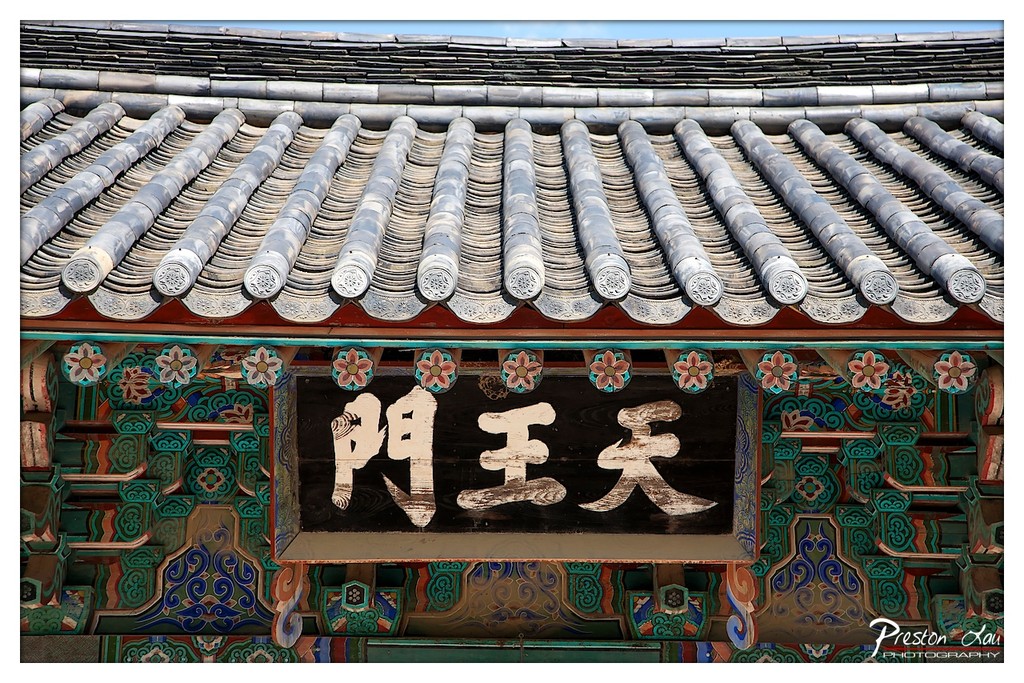

1. Overall Rating (0–10) — 8.0
This photograph captures the quiet dignity of traditional Korean architecture, where intricate craftsmanship meets cultural symbolism. The bold contrast between the weathered wooden sign and the vibrant, ornate bracketing draws the eye to the central characters, while the orderly roof tiles provide a rhythmic, almost musical backdrop. The image balances historical authenticity with aesthetic clarity, though the slight overexposure in the sky tempers its full visual potential.
2. Composition (0–10) — 8.5
The centered placement of the sign creates a strong focal point, while the symmetrical arrangement of the roof tiles and painted brackets provides visual harmony. The framing is tight yet balanced, emphasizing detail without sacrificing context.
3. Lighting (0–10) — 7.0
Natural daylight illuminates the scene evenly, enhancing the textures of the wood and tile. However, the sky is slightly blown out, reducing tonal depth in the upper portion of the frame.
4. Color & Tone (0–10) — 8.5
The rich, saturated hues of the painted wood—deep greens, reds, and blues—create a dynamic contrast with the neutral tones of the tiles and sign. The warm undertones of the wood lend a sense of age and authenticity.
5. Creativity (0–10) — 8.0
The photograph elevates a moment of architectural detail into a visual narrative, using cultural symbolism and composition to convey tradition and reverence. The choice to focus on the sign and bracketing, rather than the full structure, gives the image a contemplative, almost ceremonial quality.
6. Technical Quality (0–10) — 8.5
Sharp focus across the frame, precise detail in the wood grain and tile texture, and clean exposure in the main subject area demonstrate strong technical control. The watermark is unobtrusive and professionally placed.
7. Emotional Impact (0–10) — 7.5
The image evokes a sense of reverence for heritage and craftsmanship, inviting the viewer to pause and reflect on the cultural weight embedded in everyday structures. The quiet beauty of the scene resonates with a calm, enduring dignity.
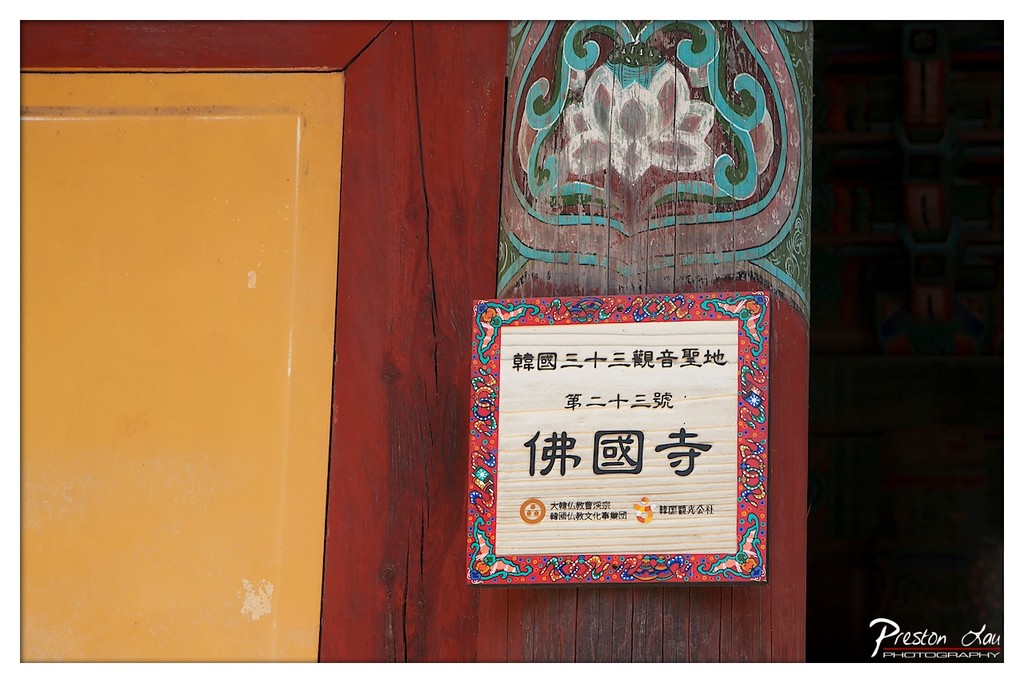

1. Overall Rating (0–10) — 7.0
This photograph captures the quiet dignity of a Korean temple entrance, where tradition and reverence are etched into both wood and script. The rich red and gold hues, combined with the ornate floral motif, evoke a sense of spiritual heritage, while the sign’s clear text grounds the image in cultural specificity. Though the composition feels slightly static, the image succeeds in conveying the solemn beauty of a sacred space, inviting contemplation through its careful balance of color and detail.
2. Composition (0–10) — 7.0
The sign is well-placed within the frame, drawing the eye with its ornate border and central text. The contrast between the vibrant yellow door and the deep red wood creates visual tension, while the dark background enhances depth and focus.
3. Lighting (0–10) — 6.5
Soft, directional lighting highlights the textures of the wood and paint, enhancing the image’s tactile quality. A slight underexposure in the shadows adds mood, though some detail is lost in the darker areas.
4. Color & Tone (0–10) — 8.0
The warm palette—rich reds, golden yellows, and accents of turquoise and white—creates a harmonious and culturally resonant atmosphere. The tones are well-saturated without appearing artificial, giving the image a natural, almost ceremonial warmth.
5. Creativity (0–10) — 7.5
The juxtaposition of traditional Korean architectural elements with modern signage offers a layered narrative of continuity and preservation. The choice to frame the sign within its cultural context elevates it beyond a simple documentary shot.
6. Technical Quality (0–10) — 8.0
Sharp focus on the sign and surrounding details reveals fine textures in the wood grain and paint. The depth of field is controlled, with a slight blur in the background that keeps the subject prominent.
7. Emotional Impact (0–10) — 7.0
The image evokes a sense of reverence and quiet contemplation, drawing the viewer into a space where history and faith converge. The viewer is invited to pause and reflect, even if only momentarily, on the enduring presence of cultural heritage.
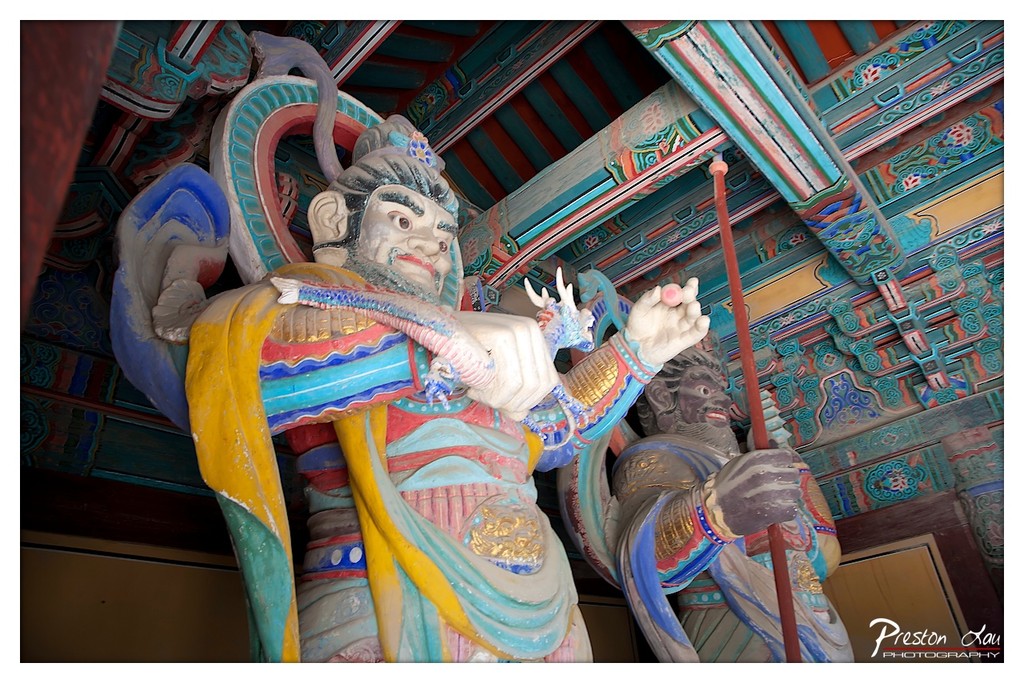

1. Overall Rating (0–10) — 8.0
This photograph captures the commanding presence of a traditional East Asian guardian statue with vivid clarity and rich cultural texture. The intricate details of the figure’s ornate armor and expressive features are beautifully highlighted, while the surrounding painted architecture adds depth and context. The image successfully conveys the spiritual gravity and artistic craftsmanship of the subject, though the tight framing slightly limits the sense of scale and environment.
2. Composition (0–10) — 7.5
The low-angle perspective emphasizes the statue’s imposing stature, while the diagonal lines of the ceiling and the positioning of the second figure create dynamic movement. However, the tight crop slightly compresses the surrounding architectural details, reducing the overall sense of space.
3. Lighting (0–10) — 7.0
Natural light filters in from the side, accentuating the texture and color depth of the sculpture without creating harsh shadows. The lighting enhances the three-dimensionality of the figure, though some areas in the background remain underexposed.
4. Color & Tone (0–10) — 9.0
The palette is striking, with bold contrasts between the deep blues, golds, and reds of the statue and the painted ceiling. The colors are rich and saturated, evoking the vibrancy of traditional temple art, while the tonal balance supports a sense of historical grandeur.
5. Creativity (0–10) — 8.5
The photographer’s choice to focus on the interplay between the statue and its ornate surroundings demonstrates a strong artistic intent. The image goes beyond mere documentation, capturing the spiritual and cultural essence of the site with a sense of reverence and visual storytelling.
6. Technical Quality (0–10) — 8.0
Sharp focus on the main figure ensures clarity in the intricate details, and the exposure is well-managed despite the complex lighting conditions. The image is free of significant technical flaws, with clean detail and balanced color rendering.
7. Emotional Impact (0–10) — 8.0
The image evokes a sense of awe and respect, drawing the viewer into the sacred atmosphere of the temple. The intensity of the guardian’s expression, combined with the rich cultural context, creates a powerful emotional resonance that invites contemplation.
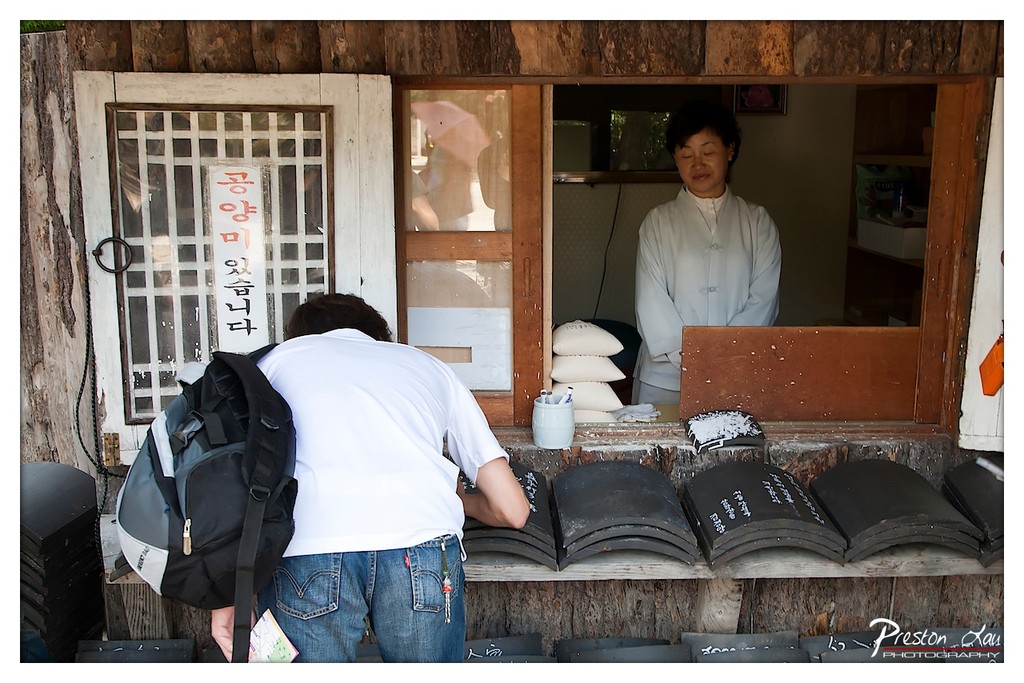

1. Overall Rating (0–10) — 7.0
This photograph captures a quiet, candid moment at a traditional Korean market stall, where the interplay of cultural authenticity and everyday life unfolds with understated grace. The composition draws the viewer into a scene of simple human exchange, grounded in texture and detail. While the lighting and color palette lean toward realism rather than dramatic artistry, the image succeeds in conveying a sense of place and quiet dignity, though it lacks a compelling focal tension to elevate it beyond documentary.
2. Composition (0–10) — 7.0
The framing balances the customer in the foreground with the vendor in the background, creating a layered narrative. The placement of the curved black tiles and the vertical signage adds rhythm and visual interest, though the left side feels slightly crowded.
3. Lighting (0–10) — 6.5
Natural daylight illuminates the scene evenly, preserving detail without harsh shadows. The light feels functional rather than artistic, supporting the documentary quality but not enhancing mood.
4. Color & Tone (0–10) — 6.0
The palette is restrained, dominated by earthy browns, muted whites, and the stark black of the tiles. The subtle red in the Korean text provides a focal point, but overall tonal contrast is modest, limiting visual impact.
5. Creativity (0–10) — 6.5
The image captures a slice of cultural life with authenticity, but its strength lies in observation rather than expressive innovation. The juxtaposition of modern backpack and traditional setting hints at cultural continuity, though it’s not fully developed.
6. Technical Quality (0–10) — 7.5
Sharp focus on the central figures and clean detail in the textures of wood and fabric suggest strong technical execution. The exposure is well-managed, with no obvious flaws.
7. Emotional Impact (0–10) — 6.5
There is a quiet dignity in the vendor’s posture and the customer’s engagement, evoking a sense of respect and routine. The emotional resonance is subtle, inviting contemplation of daily life rather than stirring strong feeling.
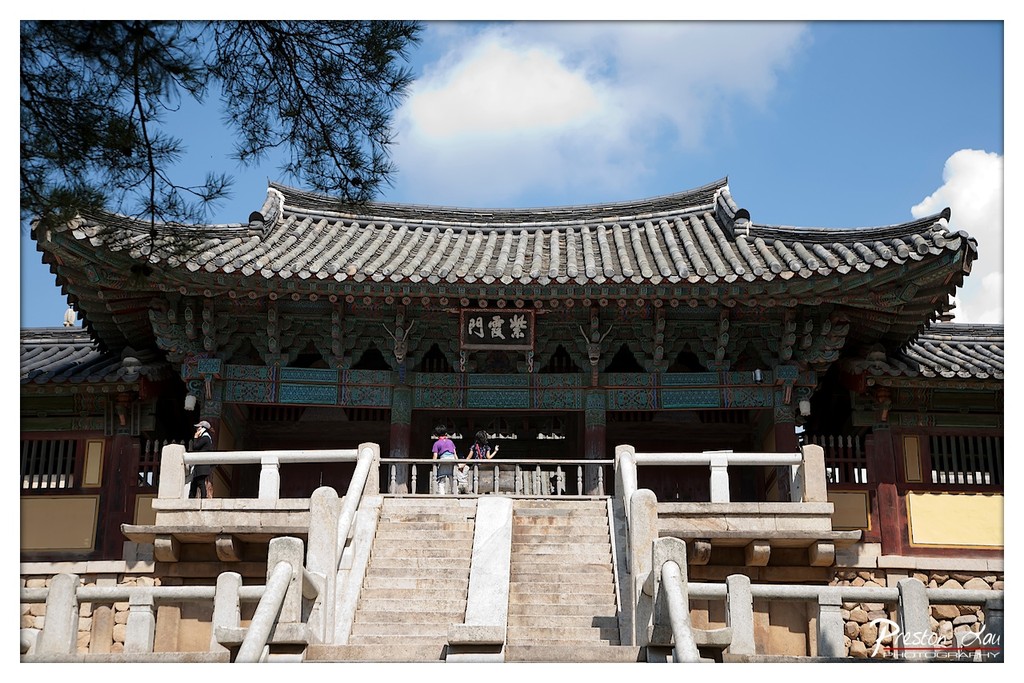

1. Overall Rating (0–10) — 7.5
This photograph captures the serene grandeur of a traditional Korean temple, where ancient architecture meets the quiet rhythm of daily life. The composition balances cultural richness with natural beauty, emphasizing the harmony between human craftsmanship and the sky. While the image is visually compelling, a slightly more dynamic angle or tighter framing could elevate its artistic impact beyond mere documentation.
2. Composition (0–10) — 7.0
The low-angle perspective emphasizes the temple’s imposing roofline and verticality, while the stone staircase draws the eye upward toward the entrance. The overhanging pine branches frame the top left, adding depth and natural contrast. However, the inclusion of several tourists on the balcony slightly disrupts the scene’s tranquility and introduces minor visual clutter.
3. Lighting (0–10) — 8.0
Bright, natural daylight enhances the details of the ornate eaves and painted beams, casting soft shadows that define the temple’s structure. The clear blue sky and scattered clouds provide a vivid backdrop, creating a strong contrast that highlights the architectural elements without overpowering them.
4. Color & Tone (0–10) — 7.5
The palette features a harmonious blend of deep blues, earthy grays, and warm wood tones, with subtle hints of red and green in the decorative elements. The colors are rich and balanced, enhancing the cultural authenticity of the scene, though the overall tone leans slightly toward coolness due to the strong sky presence.
5. Creativity (0–10) — 7.0
The image successfully captures a moment of cultural and spiritual significance, blending historical architecture with contemporary life. The inclusion of people adds narrative depth, suggesting the temple’s continued relevance, though the composition remains relatively conventional in its approach.
6. Technical Quality (0–10) — 8.5
The photograph is sharp and well-focused, with excellent clarity in both the foreground and background. The dynamic range is well-managed, preserving detail in both the bright sky and shaded architectural areas. The watermark is discreet and does not detract from the image.
7. Emotional Impact (0–10) — 7.0
The image evokes a sense of reverence and timelessness, inviting contemplation of tradition and continuity. The presence of visitors grounds the scene in reality, creating a subtle emotional connection between past and present, though the emotional resonance is tempered by the slight busyness of the central platform.
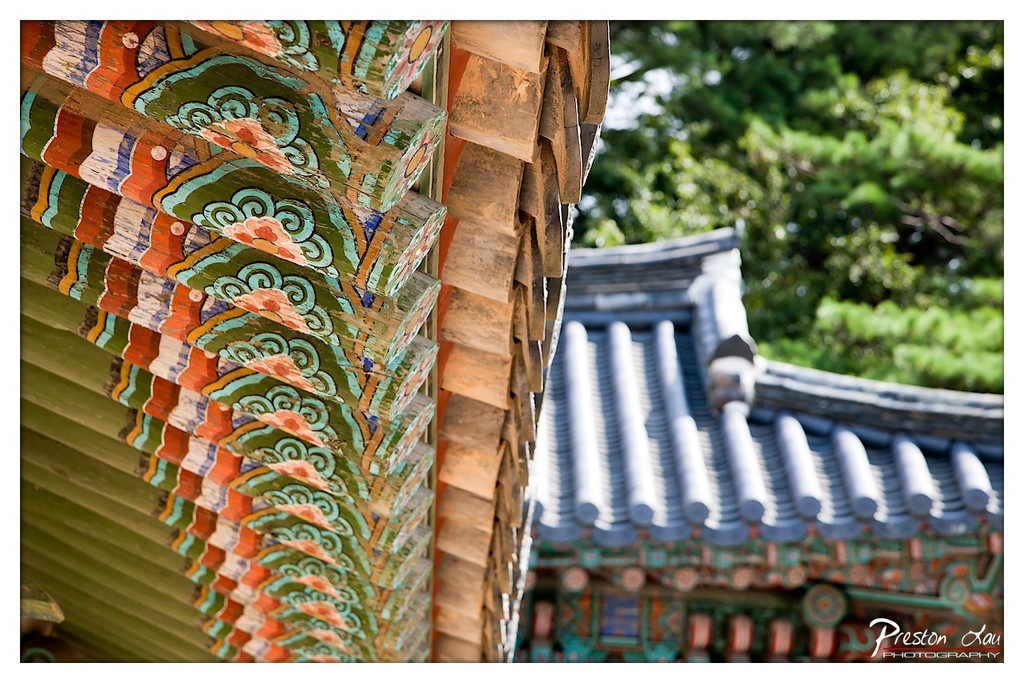

1. Overall Rating (0–10) — 8.0
This photograph captures the ornate beauty of traditional Korean architecture with vivid clarity and rich cultural texture. The juxtaposition of the colorful, weathered eaves against the soft-focus tiled roof and lush greenery creates a harmonious balance between detail and atmosphere. While the composition is strong, a more deliberate framing might elevate the image from a beautiful snapshot to a fully immersive visual narrative.
2. Composition (0–10) — 7.5
The diagonal arrangement of the painted eaves leads the eye dynamically into the frame, creating depth and rhythm. The blurred background roof and foliage provide context without distracting from the primary subject, though the tight crop slightly limits the sense of architectural scale.
3. Lighting (0–10) — 8.0
Natural daylight enhances the vibrancy of the colors, with soft highlights emphasizing the texture of the wood and paint. The light is evenly distributed, avoiding harsh shadows and allowing the intricate patterns to stand out with clarity and warmth.
4. Color & Tone (0–10) — 9.0
The palette is rich and harmonious, with deep greens, warm oranges, and soft blues creating a visually striking contrast. The tones are well-balanced and saturated without appearing unnatural, enhancing the cultural and artistic character of the scene.
5. Creativity (0–10) — 8.0
The photographer captures a moment of quiet elegance by focusing on the interplay of pattern, color, and tradition. The selective focus adds a contemplative quality, inviting the viewer to appreciate both the craftsmanship and the passage of time.
6. Technical Quality (0–10) — 8.5
Sharp focus on the foreground details contrasts effectively with the soft background, demonstrating strong control of depth of field. The image is clean, well-exposed, and free of noise or technical flaws.
7. Emotional Impact (0–10) — 8.0
The photograph evokes a sense of reverence and timelessness, connecting the viewer to a cultural heritage that feels both enduring and deeply human. The warmth of the colors and the quiet beauty of the scene invite reflection and appreciation.
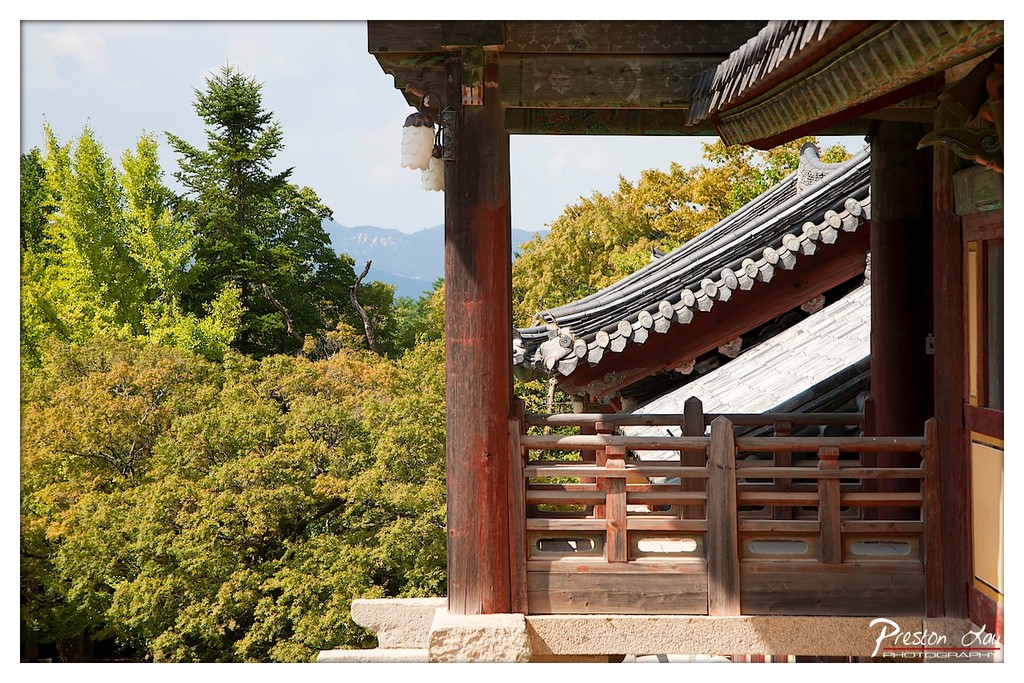

1. Overall Rating (0–10) — 7.5
This photograph captures the serene harmony of traditional Korean architecture nestled within a lush, natural landscape. The interplay of weathered wood, curved tile roofs, and vibrant foliage creates a tranquil, contemplative mood, evoking a sense of timelessness. While the composition is strong and the scene rich in cultural detail, the slightly overexposed sky and modest color vibrancy hold it back from achieving full visual resonance.
2. Composition (0–10) — 8.0
The framing uses the wooden structure as a natural vignette, drawing the eye toward the distant mountains and trees. The diagonal lines of the roof and railings create dynamic movement, while the balance between architectural elements and nature enhances depth and perspective.
3. Lighting (0–10) — 7.0
Natural daylight illuminates the scene evenly, with soft shadows that highlight the texture of the wood and tiles. The bright sky, however, is slightly overexposed, losing detail in the clouds and creating a minor contrast imbalance.
4. Color & Tone (0–10) — 7.0
The palette is dominated by earthy browns and greens, complemented by the muted gray of the tiles. While the colors are natural and harmonious, they lack richness and saturation, giving the image a slightly flat appearance.
5. Creativity (0–10) — 8.0
The image effectively combines architectural detail with natural scenery, offering a narrative of cultural continuity and peaceful coexistence with nature. The framing choice adds a contemplative, almost painterly quality, elevating it beyond a simple travel snapshot.
6. Technical Quality (0–10) — 8.0
Sharp focus and clean detail are evident in the wood grain and roof tiles, with minimal noise. The exposure is generally well-managed, though the sky’s brightness slightly undermines technical precision.
7. Emotional Impact (0–10) — 7.5
The photograph conveys calm and reverence, inviting the viewer to pause and reflect. The quiet beauty of the temple setting, framed by nature, stirs a sense of peace and connection to tradition, making it emotionally engaging.
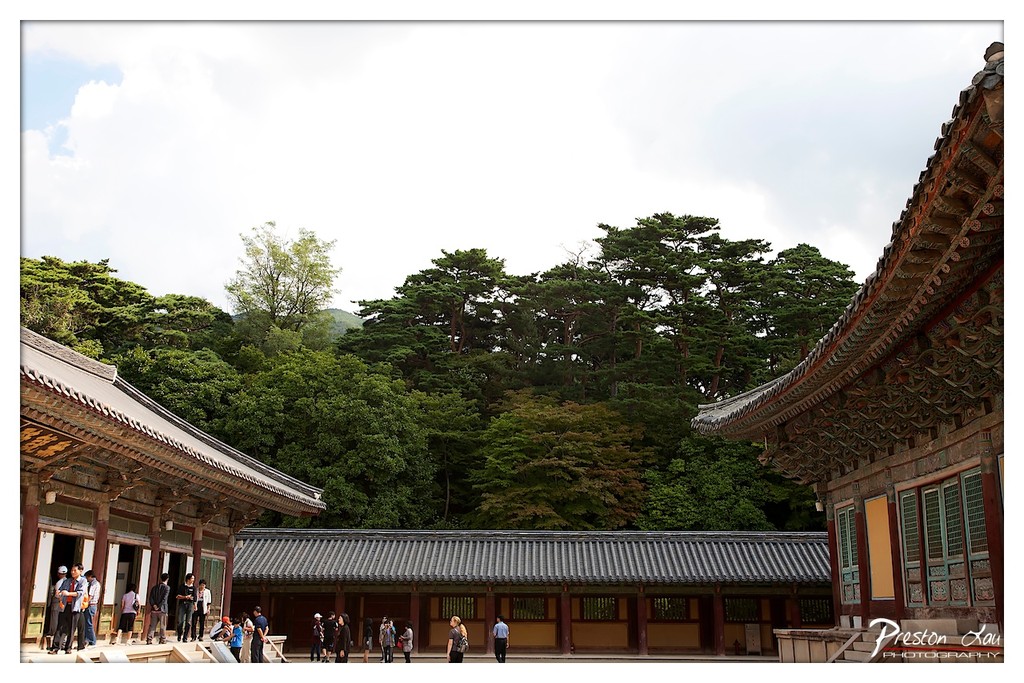

1. Overall Rating (0–10) — 7.0
This photograph captures the serene grandeur of a traditional Korean temple courtyard, where architecture and nature coexist in quiet harmony. The composition draws the eye across the open space, with visitors adding scale and life to the scene, while the lush green backdrop enhances the sense of tranquility. While the image successfully conveys the cultural and spatial depth of the site, the flat lighting and slightly cluttered foreground prevent it from achieving a more compelling visual resonance.
2. Composition (0–10) — 7.0
The framing balances the traditional structures on either side, creating a natural gateway toward the central courtyard and the forested hill beyond. The placement of people provides a sense of scale and movement, though the left-side gathering slightly disrupts the visual flow.
3. Lighting (0–10) — 6.0
The overcast sky produces soft, diffused light that minimizes harsh shadows and evenly illuminates the scene. While this enhances detail in the architecture, it also flattens the image’s depth and reduces the dramatic interplay between light and shadow.
4. Color & Tone (0–10) — 6.5
The palette is dominated by earthy tones—warm browns of the wood, deep greens of the trees, and muted grays of the tiles—creating a cohesive and naturalistic atmosphere. However, the colors lack vibrancy, and the overall tone leans slightly cool, dampening the warmth of the wooden structures.
5. Creativity (0–10) — 7.0
The image offers a respectful and authentic portrayal of a cultural site, with a thoughtful balance between human presence and architectural grandeur. While not overtly experimental, the choice to include visitors grounds the scene in lived experience, adding narrative depth.
6. Technical Quality (0–10) — 7.5
The focus is sharp across the frame, with fine detail visible in the roof tiles and wooden carvings. The exposure is well-balanced, and there are no noticeable technical flaws, though the slightly low contrast reduces the image’s overall punch.
7. Emotional Impact (0–10) — 7.0
The photograph evokes a sense of peace and contemplation, inviting the viewer to imagine the quiet rituals that take place within this sacred space. The presence of visitors adds a subtle human connection, making the scene feel both timeless and alive.
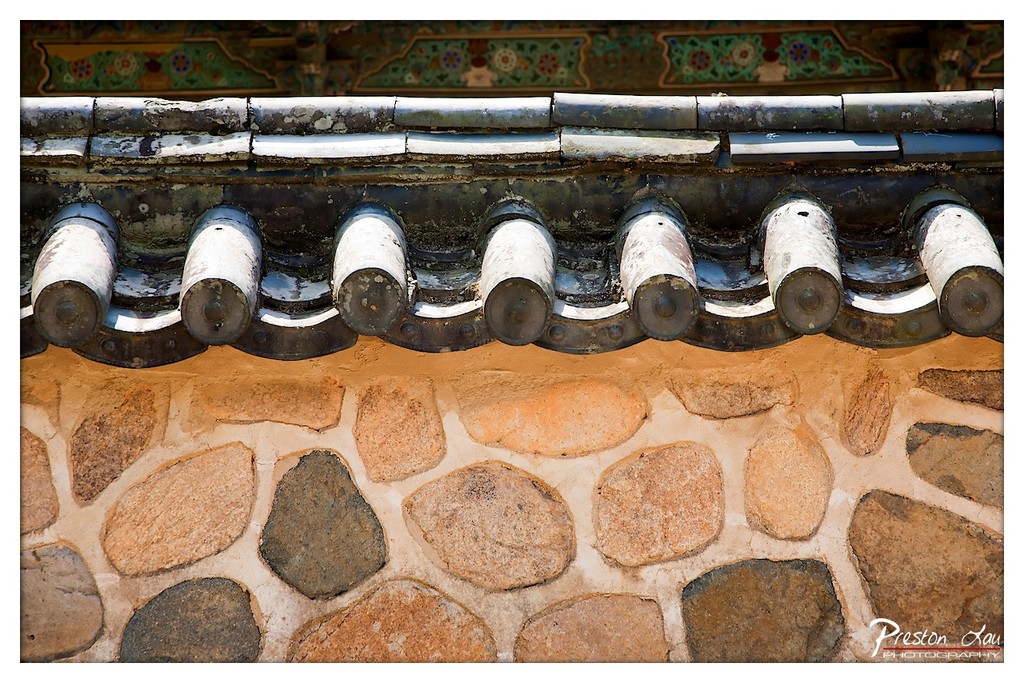

1. Overall Rating (0–10) — 7.5
This photograph captures the quiet elegance of traditional Korean architecture, where weathered textures and rich detail tell a story of time and craftsmanship. The interplay of stone, tile, and painted ornamentation creates a visually layered composition that feels both ancient and timeless. While the image excels in texture and cultural resonance, it could benefit from a slightly more dynamic perspective to elevate its visual impact.
2. Composition (0–10) — 7.0
The framing centers the curved roofline and stone wall, creating a balanced, rhythmic structure. The horizontal alignment of the tiles guides the eye across the frame, while the contrast between the rough stone and smooth tile adds visual interest. A slightly tighter crop might enhance focus on the architectural details.
3. Lighting (0–10) — 7.5
Natural daylight highlights the textures and subtle variations in material, casting soft shadows that emphasize depth. The light is even and clear, allowing the details of the tiles and stonework to emerge without harsh glare or overexposure.
4. Color & Tone (0–10) — 7.0
The palette is warm and earthy, dominated by the terracotta tones of the stone and the muted gray and white of the tiles. The green and gold accents in the background add a touch of vibrancy, though they remain subdued, preserving the image’s traditional and understated tone.
5. Creativity (0–10) — 7.5
The photograph demonstrates a strong sense of place and cultural appreciation, focusing on architectural details that are often overlooked. The choice to isolate this section of the building emphasizes texture and pattern, transforming a functional structure into a study in form and history.
6. Technical Quality (0–10) — 8.0
Sharp focus and high resolution capture fine details in both the stonework and the glazed tiles. The depth of field is well-managed, with consistent clarity across the frame. The watermark is subtle and does not detract from the image.
7. Emotional Impact (0–10) — 7.0
The image evokes a sense of reverence and quiet contemplation, inviting the viewer to appreciate the enduring beauty of traditional craftsmanship. The weathered textures and deliberate composition create a meditative mood, connecting the viewer to the passage of time and cultural heritage.
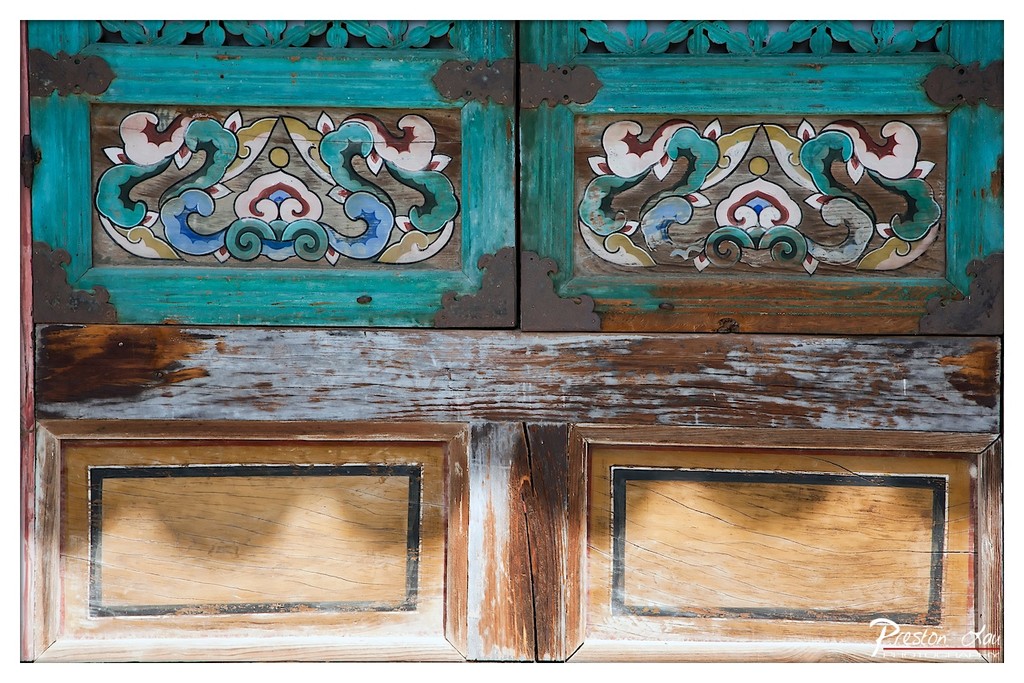

1. Overall Rating (0–10) — 7.5
This photograph captures the quiet elegance of traditional Korean woodwork, where weathered textures and vibrant painted motifs coexist in harmonious contrast. The rich teal and earthy tones evoke a sense of history and craftsmanship, while the symmetry of the design lends a formal grace. Though the image is strong in detail and composition, the slightly overexposed upper section tempers its visual depth, preventing it from achieving full emotional resonance.
2. Composition (0–10) — 8.0
The symmetrical framing emphasizes the ornamental balance of the doors, with the central horizontal division creating a natural visual rhythm. The placement of the painted panels above the plain wooden sections guides the eye downward, enhancing the sense of structure and tradition.
3. Lighting (0–10) — 6.5
The lighting is bright and even, highlighting the intricate details of the painted designs and the grain of the aged wood. However, the upper portion of the image appears slightly washed out, reducing contrast in the most colorful area and diminishing the depth of the teal finish.
4. Color & Tone (0–10) — 8.0
The palette is rich and evocative, with the bold turquoise and accents of red, white, and gold creating a vivid contrast against the natural wood tones. The tonal variation between the painted and unpainted surfaces enhances visual interest, though the slightly muted midtones in the lower section slightly temper the overall vibrancy.
5. Creativity (0–10) — 8.0
The image successfully blends cultural specificity with a strong graphic sensibility, transforming a simple architectural detail into a compelling visual narrative. The deliberate focus on symmetry and texture reveals a thoughtful approach to capturing tradition through a modern lens.
6. Technical Quality (0–10) — 8.5
The image is sharp and well-focused, with fine detail visible in both the paintwork and wood grain. The clean edges and consistent exposure across the frame demonstrate strong technical control, though the slight overexposure in the top section is a minor flaw.
7. Emotional Impact (0–10) — 7.0
There’s a quiet reverence in the image that speaks to the endurance of cultural craftsmanship. The weathered surfaces and faded pigments suggest stories of time and use, inviting contemplation. While not emotionally charged, the photograph carries a dignified stillness that resonates with a sense of heritage.
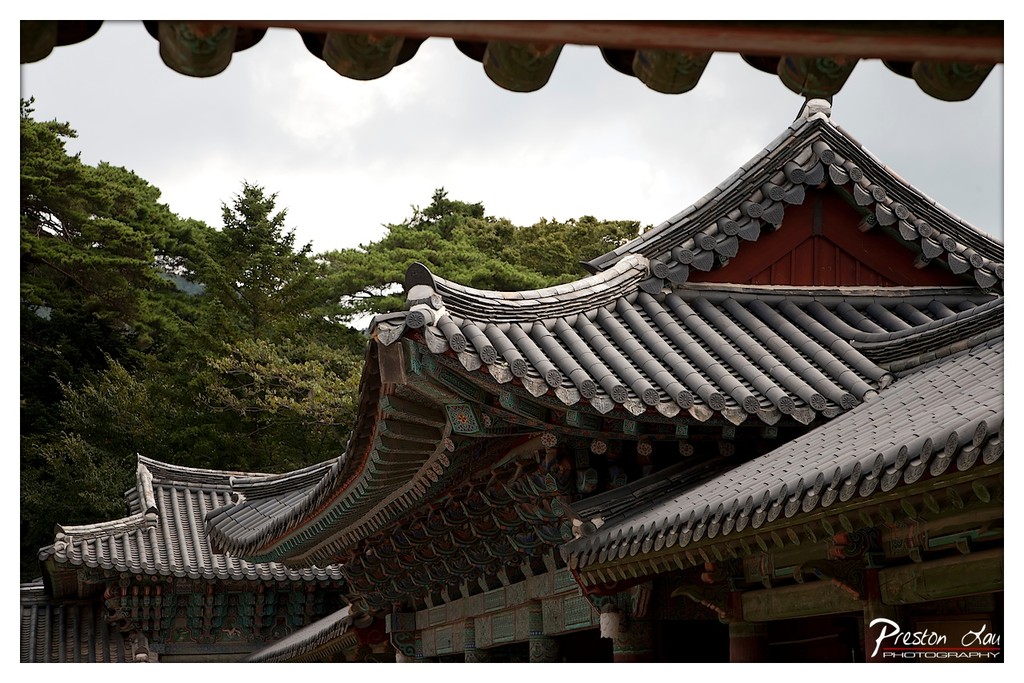

1. Overall Rating (0–10) — 7.5
This photograph captures the serene elegance of traditional Korean architecture, with its sweeping tiled roofs and ornate details framed by a natural backdrop of dense green trees. The composition draws the viewer into the scene through a partial view from beneath a roofline, creating a sense of discovery and cultural immersion. While the lighting is somewhat subdued, the image successfully conveys the quiet dignity of the temple complex, though it could benefit from stronger contrast to fully highlight the intricate craftsmanship.
2. Composition (0–10) — 8.0
The framing through the eaves creates a natural border, guiding the eye toward the layered rooftops and adding depth. The diagonal lines of the roofs lead the viewer’s gaze across the frame, with the trees in the background providing a soft contrast to the rigid geometry of the architecture.
3. Lighting (0–10) — 6.0
The overcast sky results in diffused, even lighting that softens shadows and preserves detail in the tiles and painted elements. However, the lack of directional light diminishes the sense of texture and dimension, giving the scene a slightly flat appearance.
4. Color & Tone (0–10) — 7.0
The muted palette of gray tiles, deep green trees, and faded red and blue accents creates a harmonious, traditional tone. The slightly desaturated look enhances the timeless quality of the architecture, though a touch more vibrancy in the painted details would add visual interest.
5. Creativity (0–10) — 7.5
The choice to frame the image from beneath the eaves offers a unique perspective, transforming a standard architectural shot into an intimate glimpse into a sacred space. The blend of structure and nature feels both deliberate and poetic.
6. Technical Quality (0–10) — 8.0
The image is sharp and well-focused, with fine detail visible in the tiles and decorative elements. The exposure is balanced, and the watermark is discreet, preserving the integrity of the composition.
7. Emotional Impact (0–10) — 7.0
The photograph evokes a sense of tranquility and reverence, inviting the viewer to pause and reflect on the enduring beauty of cultural heritage. The framing and subject matter combine to create a contemplative mood, though the subdued lighting tempers the emotional resonance.
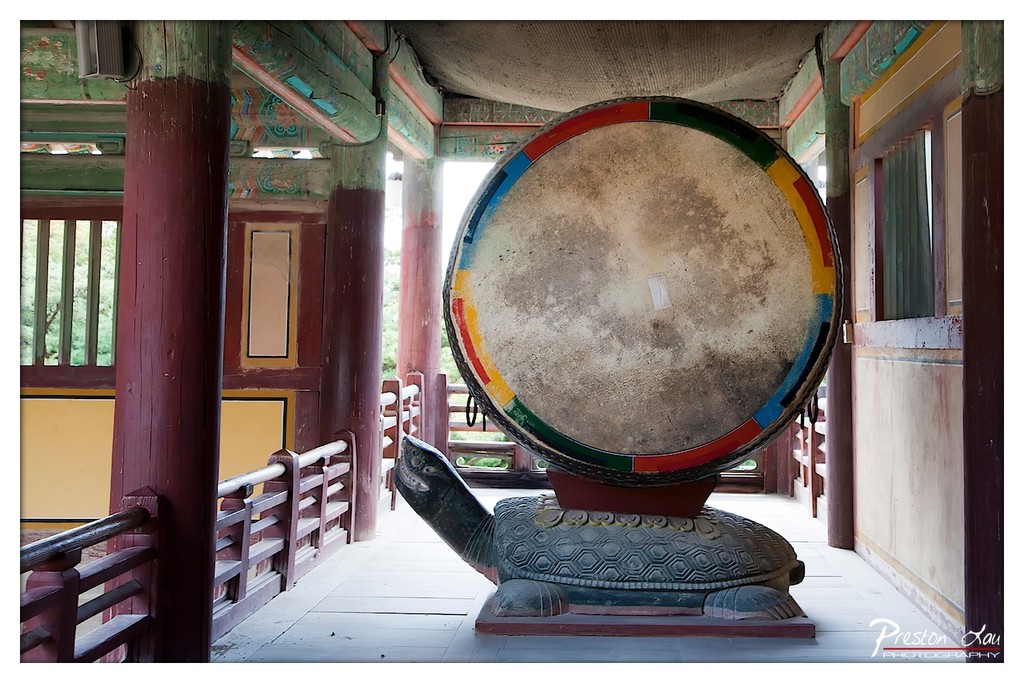

1. Overall Rating (0–10) — 7.0
This photograph captures the solemn grandeur of a traditional Korean drum, or *janggu*, resting on a turtle pedestal within a temple corridor. The vibrant colors of the drum’s rim contrast beautifully with the aged wood and weathered paint of the surrounding architecture, creating a sense of cultural depth and timelessness. While the image is rich in detail and atmosphere, the slightly cluttered foreground and uneven lighting prevent it from achieving a more refined visual harmony.
2. Composition (0–10) — 6.5
The drum is centered and dominant, drawing immediate attention, but the framing feels slightly unbalanced due to the intrusion of the wooden railing on the left. A tighter crop would enhance focus and eliminate distractions.
3. Lighting (0–10) — 6.0
Natural light filters in from the open side, illuminating the drum and highlighting its texture, though the shadows on the left side create uneven exposure and reduce detail in darker areas.
4. Color & Tone (0–10) — 7.0
The bold red, green, and yellow border of the drum provides a striking contrast against the muted earth tones of the temple interior. The color palette feels authentic and culturally resonant, with just enough saturation to avoid appearing flat.
5. Creativity (0–10) — 7.5
The image successfully blends architectural detail with cultural symbolism, using the turtle and drum as potent visual metaphors. The perspective invites contemplation of tradition and ritual, offering more than a simple documentary shot.
6. Technical Quality (0–10) — 7.5
Sharp focus and clean detail are evident in the drum’s surface and surrounding textures. The depth of field is well-managed, keeping both the foreground and background elements clear.
7. Emotional Impact (0–10) — 7.0
The stillness of the scene evokes a quiet reverence, suggesting the weight of history and ceremony. The viewer is drawn into a moment of pause, as if witnessing a sacred space untouched by time.
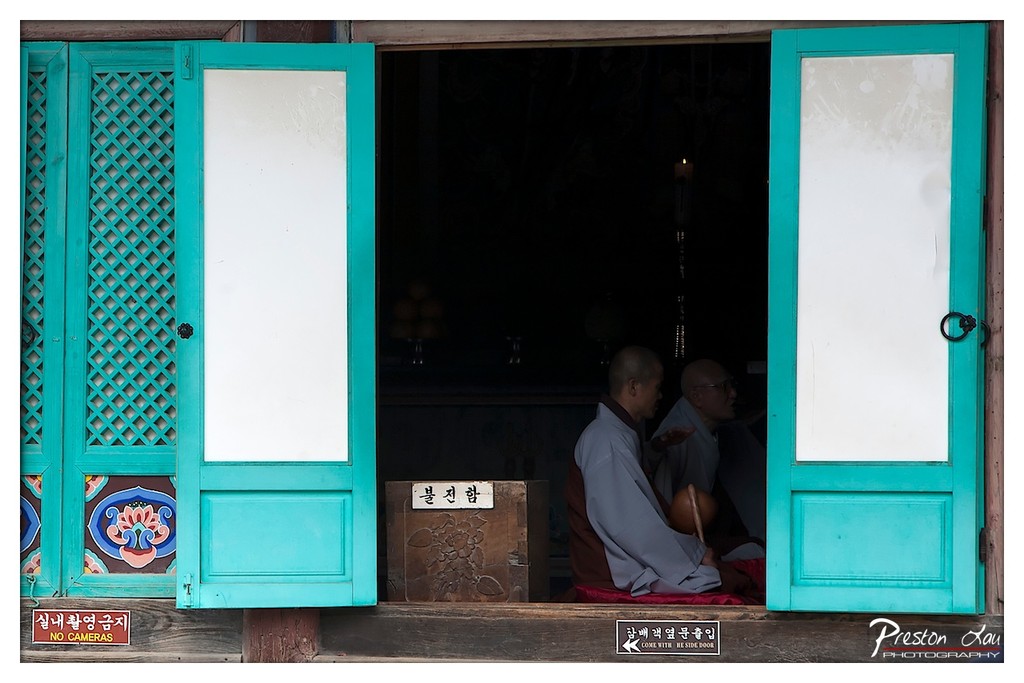

1. Overall Rating (0–10) — 7.5
This photograph captures a quiet, contemplative moment within a Korean temple, where tradition and stillness converge. The contrast between the vibrant turquoise latticework and the dark, shadowed interior creates a striking visual tension, drawing the eye toward the monks in quiet repose. While the composition is strong and the cultural context resonant, the image’s emotional depth is slightly tempered by the clutter of signage at the bottom, which distracts from the scene’s sacred stillness.
2. Composition (0–10) — 8.0
The open doorways frame the monks symmetrically, creating a balanced, almost theatrical entry into the sacred space. The placement of the subjects slightly off-center adds visual interest while maintaining a sense of harmony.
3. Lighting (0–10) — 7.5
The natural light from the exterior highlights the turquoise doors and the edges of the figures, creating a chiaroscuro effect that emphasizes the contrast between light and shadow. The interior remains in deep shadow, enhancing the sense of introspection.
4. Color & Tone (0–10) — 8.0
The vivid turquoise of the wooden lattice provides a bold, culturally rich contrast to the muted grays and browns of the monks’ robes and the dark interior. The color palette is both harmonious and evocative, reinforcing the spiritual atmosphere.
5. Creativity (0–10) — 8.0
The image transcends mere documentation by framing a moment of spiritual practice within a visually poetic structure. The interplay of light, color, and cultural detail gives the photograph a narrative depth and a sense of place.
6. Technical Quality (0–10) — 8.0
The focus is sharp on the subjects and the foreground details, with clean edges and well-managed exposure. The depth of field appropriately isolates the monks from the background while preserving the integrity of the architectural elements.
7. Emotional Impact (0–10) — 8.0
There is a palpable sense of peace and reverence that resonates through the stillness of the moment. The viewer is invited into a private space of devotion, evoking a quiet awe and connection to the spiritual practice being observed.
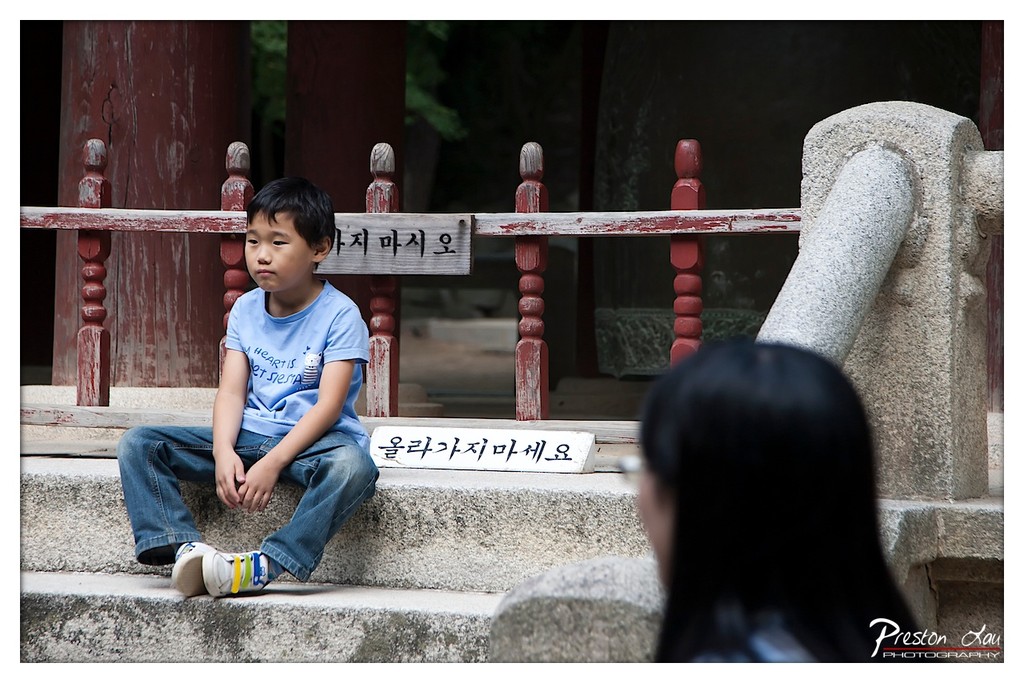

1. Overall Rating (0–10) — 7.0
This photograph captures a quiet, contemplative moment at a traditional Korean site, where a young boy’s pensive expression contrasts with the cultural backdrop of weathered wood and stone. The composition, though slightly cluttered, draws attention to the boy’s introspective mood, while the foreground figure adds depth and narrative intrigue. While the image is emotionally resonant, its technical execution and framing hold it back from true artistic cohesion.
2. Composition (0–10) — 6.5
The boy is well-placed off-center, creating visual interest, but the intrusive foreground silhouette and the busy railing distract from the focal point. A tighter crop would enhance balance and clarity.
3. Lighting (0–10) — 6.0
Natural daylight provides even illumination, but the shadows under the boy’s chin and the lack of directional modeling soften the scene’s emotional impact. The light is functional but not particularly expressive.
4. Color & Tone (0–10) — 6.5
The muted palette—dominated by blues, grays, and weathered red—complements the contemplative mood. The slightly cool tone enhances the sense of quiet, though richer saturation could elevate the visual warmth.
5. Creativity (0–10) — 7.0
The juxtaposition of childhood innocence against traditional architecture creates a subtle narrative. The use of foreground and background elements suggests a layered story, inviting interpretation beyond a simple portrait.
6. Technical Quality (0–10) — 7.5
The image is sharp and well-focused on the boy, with clean detail in the textures of the stone and wood. The depth of field is appropriately controlled, though minor distractions in the frame slightly diminish the overall polish.
7. Emotional Impact (0–10) — 7.5
The boy’s solemn expression and the quiet setting evoke a sense of introspection and cultural continuity. The viewer is drawn into a fleeting moment of stillness, creating a strong emotional connection despite the image’s modest technical execution.
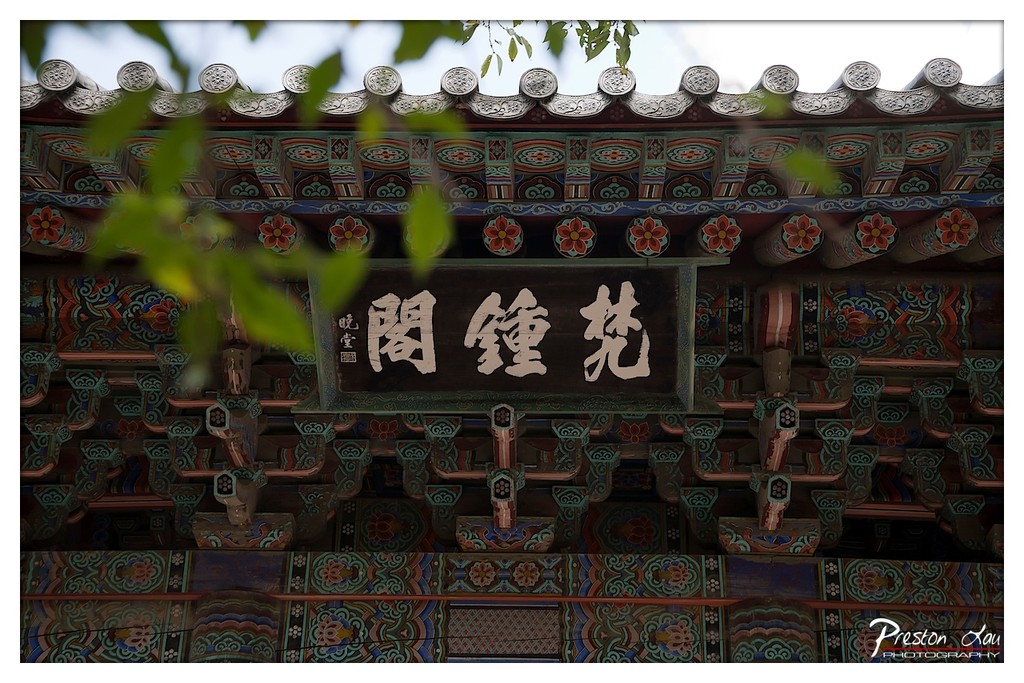

1. Overall Rating (0–10) — 7.5
This photograph captures the ornate elegance of a traditional Korean temple, where architectural detail and cultural symbolism converge. The interplay of vibrant, hand-painted motifs and the soft natural framing of green leaves creates a layered narrative that feels both reverent and poetic. While the dark tones and shadowed areas slightly mute the richness of the colors, the image succeeds in evoking the quiet dignity of a sacred space, balancing historical depth with artistic composition.
2. Composition (0–10) — 7.0
The subject is centered with intentional symmetry, drawing focus to the calligraphic sign, while the out-of-focus leaves in the foreground add depth and a sense of discovery. The framing feels deliberate, yet slightly unbalanced by the overhang of the roof on the top edge.
3. Lighting (0–10) — 6.5
Soft, diffused daylight enhances the textures of the painted wood without harsh shadows, but the lower half of the image remains underexposed, obscuring fine details. The light direction suggests an overcast sky, which preserves color integrity but limits contrast.
4. Color & Tone (0–10) — 7.5
The rich palette of reds, blues, and golds in the traditional paintwork stands out against the dark wooden background, though the overall tone is subdued. The warm tones of the leaves contrast beautifully with the cool architectural hues, creating a natural harmony.
5. Creativity (0–10) — 8.0
The use of foliage as a natural frame introduces a sense of intimacy and discovery, transforming a static architectural detail into a moment of quiet contemplation. The focus on cultural signage adds narrative weight, elevating the image beyond mere documentation.
6. Technical Quality (0–10) — 7.5
Sharp focus on the sign and surrounding details is impressive, with clean edges and minimal noise. The depth of field is well-managed, though the lower exposure could be improved for greater clarity.
7. Emotional Impact (0–10) — 8.0
The image evokes a sense of reverence and timelessness, inviting the viewer to pause and reflect on tradition and craftsmanship. The quiet presence of the temple and the subtle interplay of nature and architecture create a contemplative, almost meditative mood.
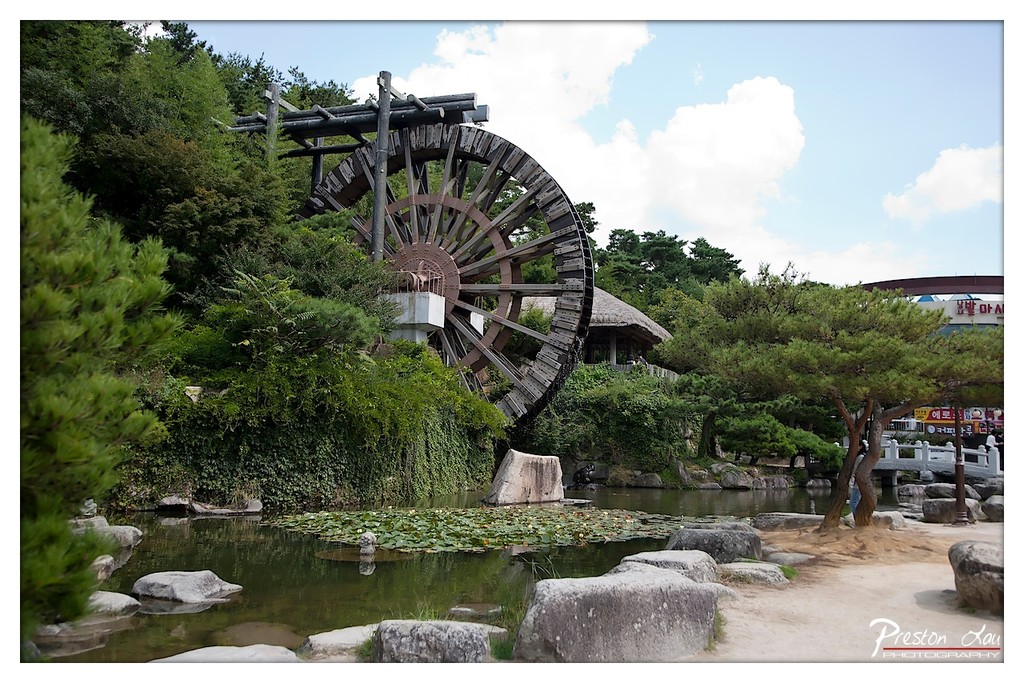

1. Overall Rating (0–10) — 7.0
This photograph captures a serene and culturally rich scene, blending traditional Korean aesthetics with natural tranquility. The waterwheel, framed by lush greenery and a reflective pond, evokes a sense of timeless harmony. While the composition is strong and the subject compelling, a slightly more intentional framing and better integration of the modern building in the background would elevate the image from picturesque to masterful.
2. Composition (0–10) — 7.0
The waterwheel is well-placed as the focal point, with the pond and rocks leading the eye toward it. The diagonal line of the path and the curve of the waterwheel create visual flow, though the inclusion of the modern building on the right slightly disrupts the traditional mood.
3. Lighting (0–10) — 7.0
Natural daylight enhances the scene with soft, even illumination, highlighting textures in the wood and foliage. The sky’s bright blue and scattered clouds add depth without overwhelming the composition.
4. Color & Tone (0–10) — 7.0
The palette is rich with earthy greens and browns, complemented by the deep blue of the sky. The contrast between the organic tones and the artificial colors of the distant signage creates a subtle tension, though the overall harmony remains intact.
5. Creativity (0–10) — 6.5
The image successfully blends natural and cultural elements, offering a narrative of tradition coexisting with modernity. However, the inclusion of the modern building and signage, while realistic, slightly undermines the intended historical atmosphere.
6. Technical Quality (0–10) — 8.0
The image is sharp and detailed, with clean focus across the frame. The exposure is well-balanced, and the dynamic range captures both the bright sky and the darker foliage effectively.
7. Emotional Impact (0–10) — 7.5
The photograph evokes a sense of peace and nostalgia, inviting the viewer to imagine a slower, more contemplative way of life. The waterwheel, surrounded by nature, becomes a symbol of enduring tradition, resonating with quiet beauty.
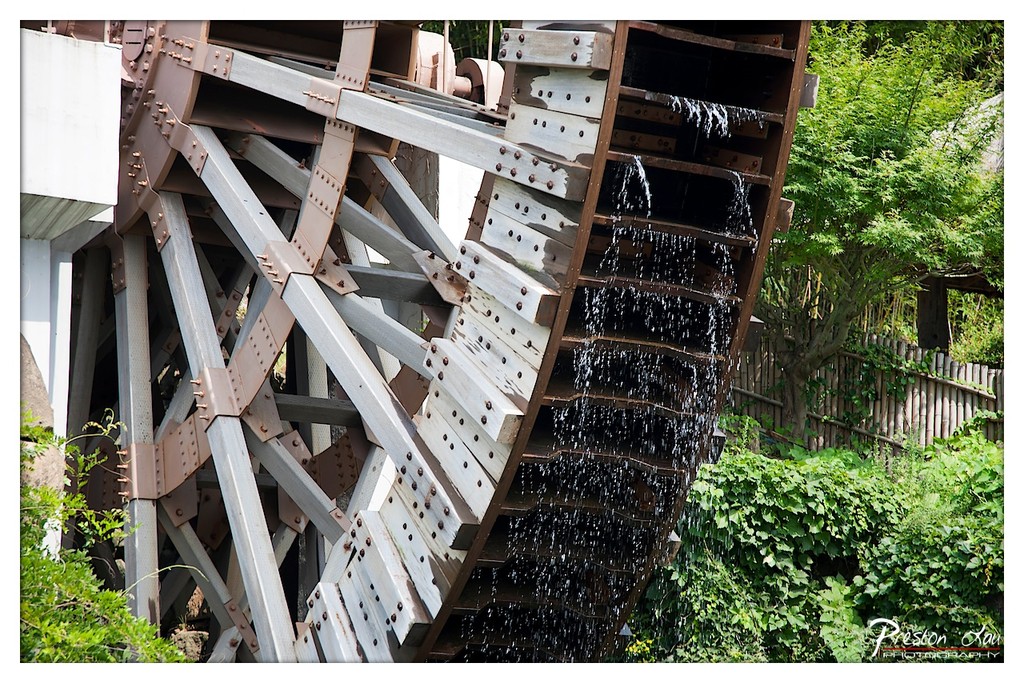

1. Overall Rating (0–10) — 7.5
This photograph captures the rhythmic motion of a waterwheel in a lush, verdant setting, blending industrial mechanics with natural beauty. The cascading water and weathered wood evoke a sense of timelessness and quiet industry, while the vibrant greenery grounds the scene in a tranquil, almost pastoral mood. The image is strong in detail and composition, though the slight clutter of surrounding foliage and structure slightly dilutes its visual focus.
2. Composition (0–10) — 7.0
The diagonal sweep of the waterwheel creates a dynamic visual path, drawing the eye from the top left to the bottom right. The framing includes both the mechanical structure and the surrounding greenery, offering context, though the left side feels slightly unbalanced due to the dense structural elements.
3. Lighting (0–10) — 7.5
Natural daylight illuminates the scene evenly, highlighting the texture of the wood and the spray of water. The soft, diffused light enhances the details without harsh shadows, creating a calm, organic atmosphere.
4. Color & Tone (0–10) — 7.0
The palette is rich with earthy browns and deep greens, complemented by the bright white of the water droplets. The contrast between the dark water and light wood adds depth, though the overall tone leans slightly toward the cool side, slightly muting the warmth of the natural setting.
5. Creativity (0–10) — 7.5
The image blends industrial and natural elements in a harmonious, almost poetic way, emphasizing the interplay between human engineering and the environment. The focus on motion and texture gives the photograph a narrative quality, suggesting stories of tradition and utility.
6. Technical Quality (0–10) — 8.0
Sharp focus across the frame ensures clarity in both the mechanical details and the water droplets. The exposure is well-balanced, and the image retains detail in both highlights and shadows, with no apparent noise or distortion.
7. Emotional Impact (0–10) — 7.0
The photograph evokes a sense of quiet contemplation and nostalgia, inviting the viewer to reflect on the passage of time and the enduring presence of simple, functional beauty. The motion of the water and the aged materials create a meditative rhythm that lingers.
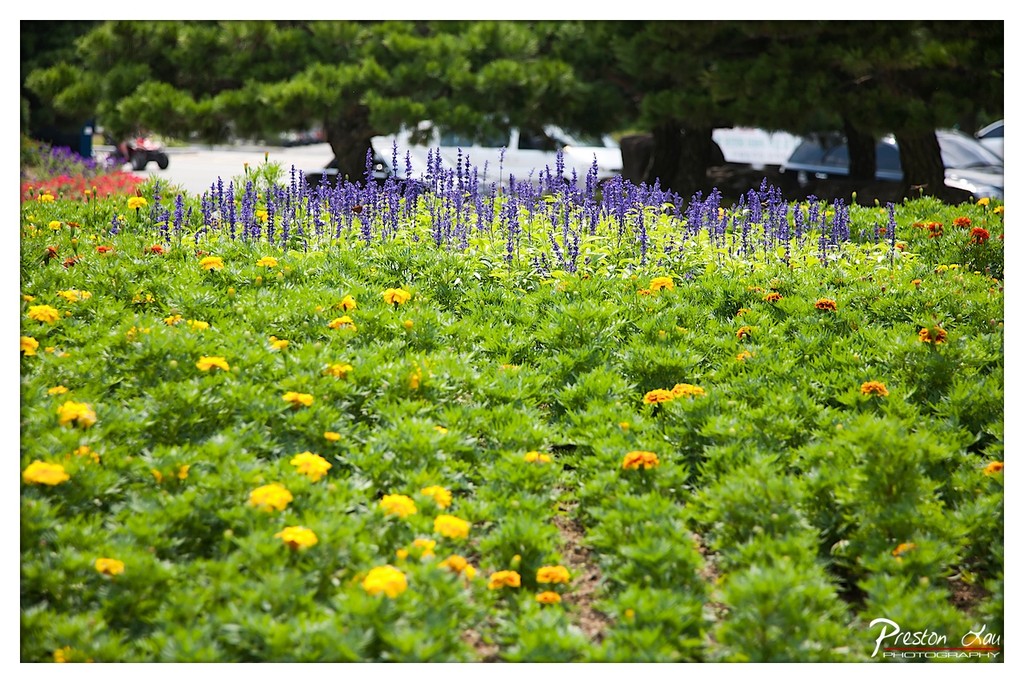

1. Overall Rating (0–10) — 7.0
This photograph captures a vibrant flower garden in full bloom, where the natural energy of color and growth creates an inviting, almost meditative atmosphere. The contrast between the vivid purple spikes and golden marigolds, set against the soft green backdrop, is visually engaging and well-balanced. While the scene is pleasing and well-composed, the intrusion of a parking lot in the background slightly disrupts the illusion of a natural landscape, grounding the image in a more urban context.
2. Composition (0–10) — 7.5
The foreground flowers are arranged in soft, rhythmic rows that lead the eye into the frame, while the background elements are softly blurred, creating a pleasing depth of field. The placement of the purple flowers slightly off-center adds visual interest, though the background cars and trees slightly distract from the organic flow.
3. Lighting (0–10) — 8.0
Natural daylight enhances the vividness of the flowers, with even illumination that avoids harsh shadows. The soft, diffused light gives the scene a gentle, summery glow, allowing the colors to pop without overexposure.
4. Color & Tone (0–10) — 8.5
The palette is rich and harmonious, with a strong contrast between the cool purples and warm yellows, enhanced by the lush green foliage. The tones are balanced and vibrant, creating a dynamic yet cohesive visual experience.
5. Creativity (0–10) — 7.0
The photograph successfully captures a moment of natural beauty with a clear eye for color and texture. While the concept is straightforward—celebrating a flower garden—the choice to include the subtle urban backdrop adds a layer of narrative, suggesting a harmony between nature and city life.
6. Technical Quality (0–10) — 8.0
The image is sharp in the mid-ground, with a well-executed shallow depth of field that isolates the flowers from the background. Focus is consistent, and the exposure is well-managed, preserving detail in both highlights and shadows.
7. Emotional Impact (0–10) — 7.5
The image evokes a sense of calm and renewal, drawing the viewer into a moment of quiet joy and natural beauty. The warmth of the colors and the soft focus on the background create a gentle emotional resonance, inviting contemplation and appreciation.
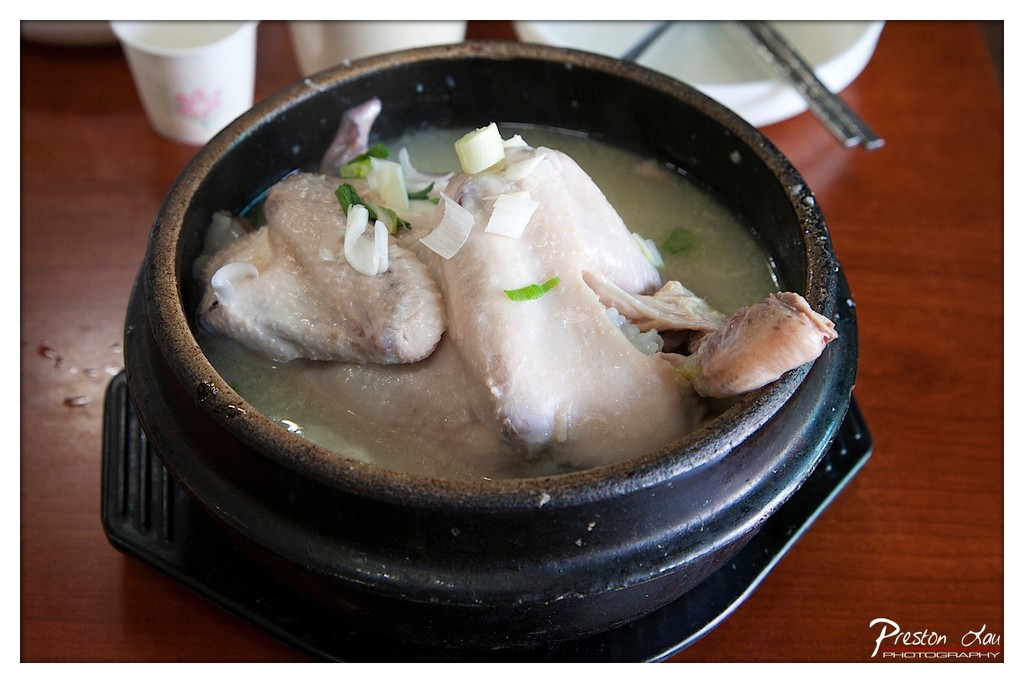

1. Overall Rating (0–10) — 6.0
This photograph captures a traditional Korean chicken soup, likely samgyetang, in a rustic stone pot, evoking warmth and cultural authenticity. The close-up perspective emphasizes the dish’s comforting, homemade quality, though the slightly cluttered background and flat lighting prevent it from feeling fully polished. While the image successfully conveys a sense of nourishment and tradition, it lacks the visual refinement to transcend a simple snapshot.
2. Composition (0–10) — 6.0
The dish is centrally framed, drawing focus to the chicken and broth, but the surrounding clutter—such as the cup and chopsticks—distracts from the main subject. A tighter crop and cleaner background would enhance visual clarity and balance.
3. Lighting (0–10) — 5.5
The lighting is flat and functional, likely from an overhead source, which highlights the texture of the food but fails to create depth or mood. The shadows are minimal, resulting in a somewhat sterile appearance despite the warm subject matter.
4. Color & Tone (0–10) — 6.0
The palette is dominated by neutral browns and whites, with subtle pops of green from the scallions. While the colors are natural and harmonious, the lack of vibrancy and contrast keeps the image from feeling dynamic or appetizing.
5. Creativity (0–10) — 6.5
The image is grounded in realism and cultural specificity, offering a genuine glimpse into a traditional meal. However, it lacks a distinctive artistic vision or narrative twist, relying more on documentation than interpretation.
6. Technical Quality (0–10) — 7.0
The focus is sharp on the chicken and broth, with good detail in the textures of the stone pot and garnishes. The image is clear and well-exposed, though minor distractions in the background slightly diminish its technical polish.
7. Emotional Impact (0–10) — 5.5
The photograph evokes a sense of comfort and tradition, but the clinical lighting and lack of emotional depth keep the viewer at arm’s length. The image feels more like a record than an invitation to experience the warmth of the meal.
Loading map...